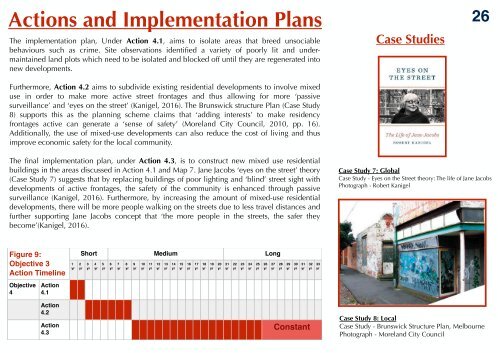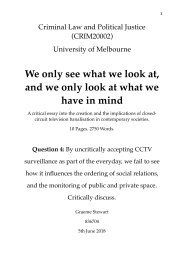FINAL SUBMISSION - intro to urban planning assignment 3
Create successful ePaper yourself
Turn your PDF publications into a flip-book with our unique Google optimized e-Paper software.
Actions and Implementation Plans<br />
The implementation plan, Under Action 4.1, aims <strong>to</strong> isolate areas that breed unsociable<br />
behaviours such as crime. Site observations identified a variety of poorly lit and undermaintained<br />
land plots which need <strong>to</strong> be isolated and blocked off until they are regenerated in<strong>to</strong><br />
new developments.<br />
Furthermore, Action 4.2 aims <strong>to</strong> subdivide existing residential developments <strong>to</strong> involve mixed<br />
use in order <strong>to</strong> make more active street frontages and thus allowing for more ‘passive<br />
surveillance’ and ‘eyes on the street’ (Kanigel, 2016). The Brunswick structure Plan (Case Study<br />
8) supports this as the <strong>planning</strong> scheme claims that ‘adding interests’ <strong>to</strong> make residency<br />
frontages active can generate a ‘sense of safety’ (Moreland City Council, 2010, pp. 16).<br />
Additionally, the use of mixed-use developments can also reduce the cost of living and thus<br />
improve economic safety for the local community.<br />
Case Studies<br />
26<br />
The final implementation plan, under Action 4.3, is <strong>to</strong> construct new mixed use residential<br />
buildings in the areas discussed in Action 4.1 and Map 7. Jane Jacobs ‘eyes on the street’ theory<br />
(Case Study 7) suggests that by replacing buildings of poor lighting and ‘blind’ street sight with<br />
developments of active frontages, the safety of the community is enhanced through passive<br />
surveillance (Kanigel, 2016). Furthermore, by increasing the amount of mixed-use residential<br />
developments, there will be more people walking on the streets due <strong>to</strong> less travel distances and<br />
further supporting Jane Jacobs concept that ‘the more people in the streets, the safer they<br />
become’(Kanigel, 2016).<br />
Case Study 7: Global<br />
Case Study - Eyes on the Street theory: The life of Jane Jacobs<br />
Pho<strong>to</strong>graph - Robert Kanigel<br />
Figure 9:<br />
Objective 3<br />
Action Timeline<br />
1<br />
yr<br />
Short Medium Long<br />
2<br />
yr<br />
3<br />
yr<br />
4<br />
yr<br />
5<br />
yr<br />
6<br />
yr<br />
7<br />
yr<br />
8<br />
yr<br />
9<br />
yr<br />
10<br />
yr<br />
11<br />
yr<br />
12<br />
yr<br />
13<br />
yr<br />
14<br />
yr<br />
15<br />
yr<br />
16<br />
yr<br />
17<br />
yr<br />
18<br />
yr<br />
19<br />
yr<br />
20<br />
yr<br />
21<br />
yr<br />
22<br />
yr<br />
23<br />
yr<br />
24<br />
yr<br />
25<br />
yr<br />
26<br />
yr<br />
27<br />
yr<br />
28<br />
yr<br />
29<br />
yr<br />
30<br />
yr<br />
31<br />
yr<br />
32<br />
yr<br />
33<br />
yr<br />
Objective<br />
4<br />
Action<br />
4.1<br />
Action<br />
4.2<br />
Action<br />
4.3<br />
Constant<br />
Case Study 8: Local<br />
Case Study - Brunswick Structure Plan, Melbourne<br />
Pho<strong>to</strong>graph - Moreland City Council



